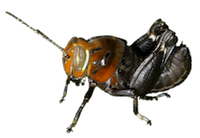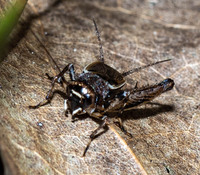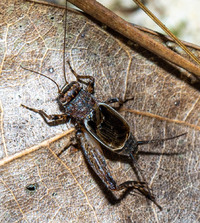Family (Alpha): ACRIDIDAE GRYLLACRIDIDAE GRYLLIDAE GRYLLOTALPIDAE RHAPHIDOPHORIDAE ROMALEIDAE TETRIGIDAE TETTIGONIIDAE TRIDACTYLIDAE
View Gryllidae Members:
Acheta domesticus Anurogryllus arboreus Gryllus unidentified species Gryllus firmus Gryllus fultoni Gryllus pennsylvanicus Gryllus pennsylvanicus/veletis Gryllus pennsylvanicus-veletis Gryllus rubens Gryllus veletis Miogryllus verticalis Velarifictorus micado Hapithus agitator Orocharis unidentified species Orocharis luteolira Orocharis saltator Cycloptilum unidentified species Cycloptilum bidens Cycloptilum pigrum Cycloptilum slossoni Cycloptilum tardum Cycloptilum trigonipalpum Cycloptilum velox Myrmecophilus pergandei Allonemobius allardi Allonemobius fultoni Allonemobius griseus griseus Allonemobius griseus funeralis Allonemobius maculatus Allonemobius socius Allonemobius sparsalsus Allonemobius tinnulus Allonemobius walkeri Allonemobius unidentified species Eunemobius carolinus Eunemobius confusus Eunemobius melodius Eunemobius unidentified species Neonemobius cubensis Neonemobius palustris Neonemobius variegatus Pictonemobius ambitiosus complex Pictonemobius ambitiosus Pictonemobius hubbelli Oecanthus unidentified species Oecanthus celerinictus Oecanthus exclamationis Oecanthus fultoni Oecanthus latipennis Oecanthus nigricornis Oecanthus niveus Oecanthus pini Oecanthus quadripunctatus Neoxabea bipunctata Phyllopalpus pulchellus Anaxipha delicatula Anaxipha exigua Anaxipha litarena Anaxipha rosamacula Anaxipha thomasi Anaxipha tinnula Anaxipha tinnulacita Anaxipha tinnulenta Anaxipha vernalis Anaxipha new species near vernalis Anaxipha unidentified species Cyrtoxipha columbiana Falcicula hebardi Gryllidae unidentified species NC Records
Pictonemobius ambitiosus (Scudder) - Ambitious Ground Cricket
Taxonomy
Family: Gryllidae
Subfamily: NemobiinaeTribe: Comments: One of four species in this genus, all of which are confined to southeastern North America (Cigliano et al., 2017). While one member of this genus has been recorded in North Carolina, it is not clear which species it represents (Gross et al., 1989).Species Status: Considered a single species -- ambitiosus -- until Gross et al. (1989) recognized three additional siblings based on songs, electrophoretic analysis, and at least partially on morphological differences. Specimens collected by Fulton (listed by Brimley, 1938), were identified as ambitiosus, but could be either the species now recognized as ambitiosus or hubbelli, which can only be distinguished by song. Both have been documented in South Carolina and seem equally likely to be the one collected by Fulton; the other two species have only been recorded in Florida or extreme southern Georgia. Although Fulton (1931) describes the song of ambitiosus, his account was based on individuals he heard in Florida and he lacked the equipment required to make an accurate measurement of pulse rate, which is needed to distinguish ambitiosus from hubbelli.
Identification
Field Guide Descriptions: Online Photographs: SINA, BugGuide , Google Images ,
iNaturalist , GBIF Technical Description, Adults/Nymphs: Hebard (1913); Gross et al. (1989)SINA 531a.htm Comments: A small, reddish-brown ground cricket. Members of this genus are distinguished by their facial markings: the face is shining black, with a narrow pale stripe between the eyes (Hebard, 1913). The vertex is also shining black but the occiput is reddish brown, similar to the color of the pronotum. In ambitiosus and hubbelli, the tegmina of the males have a pale margin that includes the tips of the wings. (Hebard, 1913; Gross et al., 1989). Hebard noted that the hind femur has a conspicuous stripe on the outer side, but Gross et al. found that character in all of the species except arenicola. Pictonemobius hubbelli is similar in appearance, but is described by Gross et al. as dark gray-brown, but the key they provide does not use that information; only the male song is used to separate the two species. In North Carolina, a specimen whose song fits the pulse rate of ambitiousus appears to be fairly dark but with some reddish shading on the dorsal surface of the pronotum.Total Length [body plus wings; excludes ovipositor]: 5.9-8 mm, males; 6-8.2 mm, females (Hebard, 1913; possibly refers to a mixture of species)Structural Features: Hindwings are absent (Gross, et al., 1989)Singing Behavior: Songs consist of a series of short trills (chirps) given at regular intervals. The length of trills measured for ambitiosus in Florida is about 0.5-0.7 sec, but is greater than 1 second in populations in South Carolina (Gross et al., 1989). Pauses between trills are about the same length as the trills themselves. Each trill is composed of a series of nearly vertical pulses, which gives the song a somewhat buzzy quality. In ambitiosus, the pulse rate is about 44-54 pulses per second at 77 F (= 25 C) (Gross et al., 1989). The dominant frequency at that temperature is around 6.7 (SINA). As noted by Fulton (1931) and evident in spectrograms at the Macaulay Library, each trill increases in amplitude from start to finish.Recording playback at normal speed.
Download Video:
"MP4"
Distribution in North Carolina
County Map: Clicking on a county returns the records for the species in that county.
Adult Dates: Click on graph to enlarge
Habitats and Life History
Habitats: Most of the species in this genus are associated with dry, open, oak woodlands growing on sandhills. At least some populations of ambitiosus in South Carolina, occur in river bottomlands or stands of mesic hardwoods (Gross et al., 1989). Diet: Probably omnivorousObservation Methods: Males sing primarily during the day and are most easily detected by their songsAbundance/Frequency: Adult Phenology: Records for ambitiosus from South Carolina are all from the summer and fall (Gross, et al., 1989)
Status in North Carolina
Natural Heritage Program Status: [W3]Natural Heritage Program Ranks: [GNR] S1S3State Protection: Comments: Members of this genus have been rarely collected even in South Carolina and the only records we have from North Carolina are the ones collected by Fulton in the 1930s. Although more needs to be learned about the species we have, their distribution and abundance, and their habitat associations, Gross et al. (1989) found that populations appeared to be highly isolated from one another, as demonstrated by large differences in their electrophoretic allozymes and other characters. In habitat species, such as these species seem to be, the lack of dispersal often means that they are highly vulnerable to the effects of habitat fragmentation. There is at least the possibility, therefore, that this species (or group of species) could be of significant conservation concern in North Carolina
Image Gallery for Pictonemobius ambitiosus - Ambitious Ground Cricket Recorded by: Steve Hall and Carol Tingley Recorded by: Steve Hall and Carol Tingley Recorded by: Steve Hall and Carol Tingley

 »
»


 »
»
